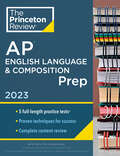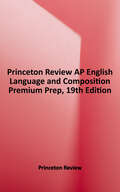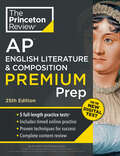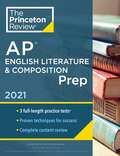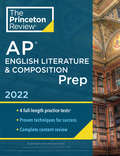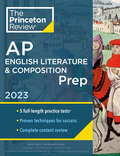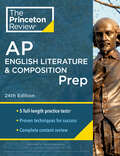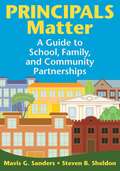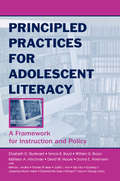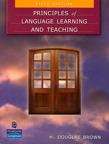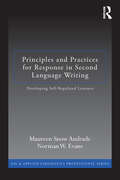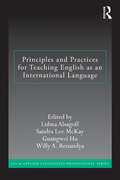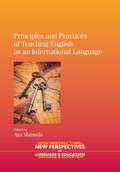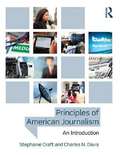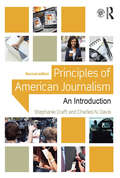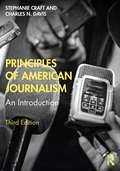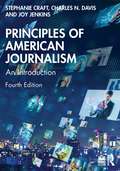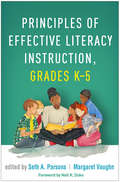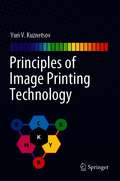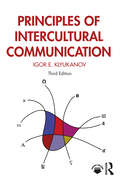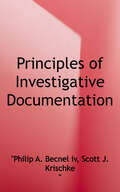- Table View
- List View
Princeton Review AP English Language & Composition Prep, 2023: 5 Practice Tests + Complete Content Review + Strategies & Techniques (College Test Preparation)
by The Princeton ReviewEVERYTHING YOU NEED TO SCORE A PERFECT 5! Ace the 2023 AP English Language & Composition Exam with this comprehensive study guide—including 5 full-length practice tests with complete explanations, thorough content reviews, targeted strategies for every section of the exam, and access to online extras. Techniques That Actually Work • Tried-and-true strategies to help you avoid traps and beat the test • Tips for pacing yourself and guessing logically • Essential tactics to help you work smarter, not harder Everything You Need for a High Score • Up-to-date information on the 2023 AP English Language & Composition Exam • Comprehensive review of the synthesis, rhetorical analysis, and argumentative essays • Engaging coverage of word use and rhetorical modes • Access to study plans, a list of key terms, helpful pre-college information, and more via your online Student ToolsPractice You Way to Excellence • 5 full-length practice tests (4 in the book, 1 online) with detailed answer explanations • Pacing drills to help you maximize points on the Reading and Writing passages • Detailed guides for the new analytical scoring rubrics
Princeton Review AP English Language and Composition Prep, 19th Edition
by The Staff of The Princeton ReviewPremium Practice For A Perfect 5! Ace the new Digital AP English Language & Composition Exam with The Princeton Review's comprehensive study guide—including 8 practice tests with answer explanations, timed online practice, and thorough content reviews. Techniques That Work - Tried-and-true strategies to help you avoid traps and beat the test - Tips for pacing yourself and guessing logically - Essential tactics to help you work smarter, not harder Everything You Need for a High Score - Updated to address the new digital exam - Comprehensive review of the synthesis, rhetorical analysis, and argumentative essays - Online digital flashcards to review core content - Access to study guides, a handy list of key terms and concepts, helpful pre-college information, and more via your online Student Tools Premium Practice for AP Excellence - 8 full-length practice tests (5 in the book, 3 online) with detailed answer explanations - Online tests provided as both digital versions (with timer option to simulate exam experience) online, and as downloadable PDFs (with interactive elements mimicking the exam interface) - Pacing drills to help you maximize points on the Reading and Writing passages
Princeton Review AP English Literature & Composition Premium Prep, 25th Edition: 5 Practice Tests + Digital Practice Online + Content Review (College Test Preparation)
by The Princeton ReviewPREMIUM PRACTICE FOR A PERFECT 5! Ace the new Digital AP English Literature & Composition Exam with The Princeton Review's comprehensive study guide—including 5 practice tests with answer explanations, timed online practice, and thorough content reviews.Techniques That Actually Work• Tried-and-true strategies to help you avoid traps and beat the test• Tips for pacing yourself and guessing logically• Essential tactics to help you work smarter, not harderEverything You Need for a High Score• Updated to address the new digital exam• Comprehensive review of the synthesis, rhetorical analysis, and argumentative essays• Coverage of terminology and rhetorical modes for improved writing• Online digital flashcards to review core content, plus study plans and more via your online Student ToolsPremium Practice for AP Excellence• 5 full-length practice tests (4 in the book, 1 online) with detailedanswer explanations• Online test provided as both a digital version (with timer option to simulate exam experience) online, and as a downloadable PDF (with interactive elements mimicking the exam interface)• Pacing drills and detailed analytical scoring rubric guides
Princeton Review AP English Literature & Composition Premium Prep, 26th Edition: 5 Practice Tests + Digital Practice Online + Content Review (College Test Preparation)
by The Princeton ReviewPREMIUM PRACTICE FOR A PERFECT 5! Ace the newly-digital AP English Literature & Composition Exam with this comprehensive study guide—including 5 practice tests with answer explanations, timed online practice, and thorough content review.Techniques That Actually Work• Tried-and-true strategies to help you avoid traps and beat the test• Tips for pacing yourself and guessing logically• Essential tactics to help you work smarter, not harderEverything You Need for a High Score• Updated to address the new digital exam• Comprehensive review of the synthesis, rhetorical analysis, and argumentative essays• Coverage of terminology and rhetorical modes for improved writing• Online digital flashcards to review core content, plus study plans and more via your online Student ToolsPremium Practice for AP Excellence• 5 full-length practice tests (3 in the book, 2 online) with detailed answer explanations• Online test provided as a digital version (with timer option to simulate exam experience) online, and as a downloadable PDF (with interactive elements mimicking the exam interface)• Pacing drills and detailed analytical scoring rubric guides• Practice drills at the end of each content review chapter, plus step-by-step walk-throughs of sample exam questions
Princeton Review AP English Literature & Composition Prep, 2021: Practice Tests + Complete Content Review + Strategies & Techniques (College Test Preparation)
by The Princeton ReviewEVERYTHING YOU NEED TO HELP SCORE A PERFECT 5—now with 33% more practice than previous editions! Ace the 2021 AP English Literature & Composition Exam with The Princeton Review's comprehensive study guide. Includes 3 full-length practice tests, thorough content reviews, targeted strategies for every section, and access to online extras.Techniques That Actually Work.• Tried-and-true strategies to help you avoid traps and beat the test• Tips for pacing yourself and guessing logically• Essential tactics to help you work smarter, not harderEverything You Need to Know to Help Achieve a High Score.• Comprehensive coverage of all test topics• Up-to-date information on the 2021 course & exam• Engaging activities to help you critically assess your progress• Access to study plans, helpful pre-college information, and more via your online Student ToolsPractice Your Way to Excellence.• 3 full-length practice tests with detailed answer explanations• Practice drills for poetry and prose passages• Sample essays with tips to help you effectively plan and organize your own writing on the day of the exam
Princeton Review AP English Literature & Composition Prep, 2022: 4 Practice Tests + Complete Content Review + Strategies & Techniques (College Test Preparation)
by The Princeton ReviewEVERYTHING YOU NEED TO HELP SCORE A PERFECT 5! Ace the 2022 AP English Literature & Composition Exam with The Princeton Review's comprehensive study guide. Includes 4 full-length practice tests, thorough content reviews, targeted strategies for every section, and access to online extras.Techniques That Actually Work.• Tried-and-true strategies to help you avoid traps and beat the test• Tips for pacing yourself and guessing logically• Essential tactics to help you work smarter, not harderEverything You Need for a High Score.• Fully aligned with the latest College Board standards for AP® English Literature & Composition• Comprehensive coverage of all test topics• Engaging activities to help you critically assess your progress• Access to study plans, helpful pre-college information, and more via your online Student Tools accountPractice Your Way to Excellence.• 4 full-length practice tests (3 in the book, 1 online) with detailed answer explanations• Practice drills for poetry and prose passages• Sample essays with tips to help you effectively plan and organize your writing on the day of the exam
Princeton Review AP English Literature & Composition Prep, 2023: 5 Practice Tests + Complete Content Review + Strategies & Techniques (College Test Preparation)
by The Princeton ReviewEVERYTHING YOU NEED TO HELP SCORE A PERFECT 5! Ace the 2023 AP English Literature & Composition Exam with The Princeton Review's comprehensive study guide. Includes 5 full-length practice tests, thorough content reviews, targeted strategies for every section, and access to online extras. Techniques That Actually Work • Tried-and-true strategies to help you avoid traps and beat the test • Tips for pacing yourself and guessing logically • Essential tactics to help you work smarter, not harder Everything You Need for a High Score • Fully aligned with the latest College Board standards for AP® English Literature & Composition • Comprehensive coverage of all test topics • Engaging activities to help you critically assess your progress • Access to study plans, helpful pre-college information, and more via your online Student Tools Practice Your Way to Excellence • 5 full-length practice tests (4 in the book, 1 online) with detailed answer explanations • Practice drills for poetry and prose passages • Sample essays with tips to help you effectively plan and organize your writing on the day of the exam
Princeton Review AP English Literature & Composition Prep, 24th Edition: 5 Practice Tests + Complete Content Review + Strategies & Techniques (College Test Preparation)
by The Princeton ReviewEVERYTHING YOU NEED TO HELP SCORE A PERFECT 5! Ace the AP English Literature & Composition Exam with The Princeton Review's comprehensive study guide. Includes 5 full-length practice tests, thorough content reviews, targeted strategies for every section, and access to online extras.Techniques That Actually Work• Tried-and-true strategies to help you avoid traps and beat the test• Tips for pacing yourself and guessing logically• Essential tactics to help you work smarter, not harderEverything You Need for a High Score• Fully aligned with the latest College Board standards for AP® English Literature & Composition• Comprehensive coverage of all test topics• Engaging activities to help you critically assess your progress• Access to study plans, helpful pre-college information, and more via your online Student ToolsPractice Your Way to Excellence• 5 full-length practice tests (4 in the book, 1 online) with detailed answer explanations• Practice drills for poetry and prose passages• Sample essays with tips to help you effectively plan and organize your writing on the day of the exam
Principals Matter: A Guide to School, Family, and Community Partnerships
by Mavis G. Sanders Steven B. SheldonResearch has shown that strong principal leadership is critical to developing effective school partnerships that include diverse school, family and community members. This book provides administrators with a clear road map for initiating partnership programs that are goal-focused, equitable, and sustainable.In this research-based resource, the authors highlight the work of principals who have cultivated successful partnerships across many settings to show other school leaders how they can develop the necessary supportive school cultures. Examining the administrator's role in the success and quality of home-school partnerships and student outcomes, this guidebook: Synthesizes research on principal leadership, school and community partnerships, and urban education reform Discusses the role of fathers in children’s learning and working with families that live in poverty, are linguistically diverse, or have children with disabilities Offers practical recommendations for evaluating and refining partnership programs to ensure they are linked with student achievement goals
Principled Practices for Adolescent Literacy: A Framework for Instruction and Policy
by David W. Moore Kathleen A. Hinchman Donna E. Alvermann William G. Brozo Fenice B. Boyd Elizabeth G. SturtevantThis book presents an evidence-based framework for understanding the literacy needs of adolescents. The premise is that educators and other critical stakeholders need to understand evidence-based principles in order to develop effective curriculum to meet the needs of diverse learners. Recommendations are provided for middle and secondary education, professional development, teacher education research and policy.At the center of the book are Eight Guiding Principles developed by the authors through a process that included an extensive review of research and policy literature in literacy and related fields, a comparison of National Standards documents, and visits to the classrooms of 28 middle and high school teachers across the United States. The Principles are broad enough to encompass a variety of contexts and student needs, yet specific enough to offer real support to those involved in program development or policy decisions. They provide an overarching structure that districts and teachers can use to develop site-specific curriculum that is both research-based and designed to meet the needs of the learners for whom they are responsible.Important Text Features: Organized to help readers understand empirically supported principles of practice that can be used to address literacy concerns in today's schools, each chapter that addresses one of the eight Principles follows a similar format:* The Principle is presented along with a brief explanation of the research base and a sample of national standards that support it.* One or more case examples spanning a wide variety of disciplines, grade levels, and local conditions - provide an in-depth look at the Principle in action.* A well-known adolescent literacy expert offers a response to each case example, giving readers an informed view of the importance of the Principle, how it is enacted in the cases, and examples of other work related to the Principle. Discussion questions are provided that can be used for individual reflection or group discussion.Principled Practices for Adolescent Literacy is intended as a text for pre-service and in-service upper-elementary, middle and high school literacy methods courses and graduate courses related to adolescent literacy, and as a resource for school district personnel, policymakers and parents.
Principles Of Language Learning And Teaching
by H. Douglas BrownPrinciples of Language Learning and Teaching, Fifth Edition, by H. Douglas Brown, is the classic second language acquisition text used by teacher education programs worldwide. Principles introduces key concepts through definitions of terms, thought-provoking questions, charts, and spiraling. New Classroom Connections encourage students to consider the implications of research for classroom pedagogy. An up-to-date bibliography and new glossary provide quick access to important works and key terminology in the field. The fifth edition takes a comprehensive look at foundations of language teaching through discussions of the latest research in the field, including: * Vygotsky's and Bakhtin's theories * Thorndike's law of effect * error treatment, noticing, recasts * intercultural communication * language policy and politics * corpus linguistics *hot topics in SLA * connectionism and emergentism * flow theory, willingness to communicate * strategies-based instruction * contrastive rhetoric * attribution theory, self-efficacy * output hypothesis Also by H. Douglas Brown: Teaching by Principles: An Interactive Approach to Language Pedagogy Language Assessment: Principles and Classroom Practices Strategies for Success: A Practical Guide to Learning English
Principles and Practices for Response in Second Language Writing: Developing Self-Regulated Learners (ESL & Applied Linguistics Professional Series)
by Maureen Snow Andrade Norman W. EvansBased on the assumptions that students expect feedback and want to improve, and that improvement is possible, this book introduces a framework that applies the theory of self-regulated learning to guide second language writing teachers’ response to learners at all stages of the writing process. This approach provides teachers with principles and activities for helping students to take more responsibility for their own learning. By using self-regulated learning strategies, students can increase their independence from the teacher, improve their writing skills, and continue to make progress once the course ends, with or without teacher guidance. The book focuses on the six dimensions of self-regulated learning —motive, methods of learning, time, physical environment, social environment, and performance. Each chapter offers practical activities and suggestions for implementing the principles and guidelines, including tools and materials that teachers can immediately use.
Principles and Practices for Teaching English as an International Language (ESL & Applied Linguistics Professional Series)
by Lubna Alsagoff Willy A. Renandya Guangwei Hu Sandra Lee McKayWhat general principles should inform a socioculturally sensitive pedagogy for teaching English as an International Language and what practices would be consistent with these principles? This text explores the pedagogical implications of the continuing spread of English and its role as an international language, highlighting the importance of socially sensitive pedagogy in contexts outside inner circle English-speaking countries. It provides comprehensive coverage of topics traditionally included in second language methodology courses (such as the teaching of oral skills and grammar), as well as newer fields (such as corpora in language teaching and multimodality); features balanced treatment of theory and practice; and encourages teachers to apply the pedagogical practices to their own classrooms and to reflect on the effects of such practices. Designed for pre-service and in-service teachers of English around the world, Principles and Practices for Teaching English as an International Language fills a critical need in the field.
Principles and Practices of Teaching English as an International Language
by Aya MatsudaThis book critically examines current ELT practices visàvis the use of English as an international lingua franca. It bridges the gap between theoretical discussion and the practical concerns of teaching English as an international language, and presents diverse approaches for preparing competent users of English in international contexts.
Principles of American Journalism: An Introduction
by Stephanie Craft Charles N. DavisIn a rapidly changing media landscape, what becomes of journalism? Designed to engage, inspire and challenge students while laying out the fundamental principles of the craft, Principles of American Journalism introduces students to the core values of journalism and its singularly important role in a democracy. From the First Amendment to Facebook, Stephanie Craft and Charles N. Davis provide a comprehensive exploration of the guiding principles of journalism--the ethical and legal foundations of the profession, its historical and modern precepts, the economic landscape, the relationships among journalism and other social institutions, and the key issues and challenges that contemporary journalists face. Case studies, discussion questions and field exercises help students to think critically about journalism's function in society, creating mindful practitioners of journalism and more informed media consumers. With its bottom line under assault, its values being challenged from without and from within and its future anything but certain, it has never been more important to think about what's unique about journalism. This text is ideal for use in introductory Principles of Journalism courses, and the companion website provides a full complement of student and instructor resources to enhance the learning experience and connect to the latest news issues and events.
Principles of American Journalism: An Introduction
by Stephanie Craft Charles N. DavisDesigned to engage, inspire and challenge students while laying out the fundamentals of the craft, Principles of American Journalism introduces readers to the core values of journalism and its singular role in a democracy. From the First Amendment to Facebook, the new and revised edition of this popular textbook provides a comprehensive exploration of the guiding principles of journalism and what makes it unique: the profession's ethical and legal foundations; its historical and modern precepts; the economic landscape of journalism; the relationships among journalism and other social institutions; the key issues and challenges that contemporary journalists face. Case studies, exercises, and an interactive companion website encourage critical thinking about journalism and its role in society, making students more mindful practitioners of journalism and more informed media consumers.
Principles of American Journalism: An Introduction
by Stephanie Craft Charles N. DavisDesigned to engage, inspire, and challenge students while laying out the fundamentals of the craft, this textbook introduces readers to the core values of journalism and its singular role in a democracy. From the First Amendment to Facebook, this popular textbook – now in its third edition – provides a comprehensive exploration of the guiding principles of journalism and what makes it unique. Authors Stephanie Craft and Charles Davis cover the profession's ethical and legal foundations, its historical and modern precepts, the economic landscape of journalism, the relationships among journalism and other social institutions, and the key issues and challenges that contemporary journalists face. They also discuss the current ambiguities and transitions – economic and technological – occurring in the field, from nonprofit news sites to social media’s effects on journalism. Filled with relevant case studies, exercises, and discussion questions that encourage critical thinking about journalism and its role in society, this book helps students become better-informed media consumers as well as more mindful practitioners of journalism. The companion website features chapter-by-chapter flashcards, quizzes, and annotated weblinks for students and a separate instructor resource section that features sample test questions, PowerPoint slides, sample syllabi, and chapter-by-chapter activities and discussion questions.
Principles of American Journalism: An Introduction
by Stephanie Craft Charles N. Davis Joy JenkinsDesigned to engage, inspire and challenge students while laying out the fundamentals of the craft, this textbook—now in its fourth edition—introduces readers to the core values of journalism and its singular role in a democracy.From the First Amendment to artificial intelligence, this popular textbook provides a comprehensive exploration of the guiding principles of journalism and what makes it unique. Authors Stephanie Craft, Charles N. Davis and Joy Jenkins cover the profession's ethical and legal foundations, its historical and modern precepts, the economic landscape of journalism, the relationships among journalism and other social institutions and the key issues and challenges that contemporary journalists face. They also discuss the current ambiguities and transitions—economic and technological—occurring in the field, from nonprofit news sites to social media’s effects on journalism.Filled with relevant case studies, exercises and discussion questions that encourage critical thinking about journalism and its role in society, this book helps students become better-informed media consumers as well as more mindful practitioners of journalism.
Principles of Automated Negotiation
by Shaheen Fatima Sarit Kraus Michael WooldridgeWith an increasing number of applications in the context of multi-agent systems, automated negotiation is a rapidly growing area. Written by top researchers in the field, this state-of-the-art treatment of the subject explores key issues involved in the design of negotiating agents, covering strategic, heuristic, and axiomatic approaches. The authors discuss the potential benefits of automated negotiation as well as the unique challenges it poses for computer scientists and for researchers in artificial intelligence. They also consider possible applications and give readers a feel for the types of domains where automated negotiation is already being deployed. This book is ideal for graduate students and researchers in computer science who are interested in multi-agent systems. It will also appeal to negotiation researchers from disciplines such as management and business studies, psychology and economics.
Principles of Effective Literacy Instruction, Grades K-5
by Seth A. Parsons, Margaret VaughnWhat are the principles that every elementary teacher must learn in order to plan and adapt successful literacy instruction? This concise course text and practitioner resource brings together leading experts to explain the guiding ideas that underlie effective instructional practice. Each chapter reviews one or more key principles and highlights ways to apply them flexibly in diverse classrooms and across grade levels and content areas. Chapters cover core instructional topics (phonemic awareness, phonics, fluency, vocabulary, and comprehension); high-quality learning environments; major issues such as assessment, differentiation, explicit instruction, equity, and culturally relevant pedagogy; and the importance of teachers&’ reflective practice and lifelong learning.
Principles of Image Printing Technology
by Yuri V. KuznetsovPrinciples of Image Printing Technology is a unique review of technology use in the printing industry since the time of the medieval engravers and busy newsroom typesetters. It provides a historical review of the advancement of technology and describes in-depth both technical fundamentals and industrial procedures. Intended primarily for students in graphic communications programs, this book includes all the necessary background for understanding printing technology. In addition, by providing findings from basic research studies and industrial processes that have been omitted elsewhere in published volumes, it offers a useful guide to researchers and professionals in the printing industry.
Principles of Intercultural Communication
by Igor E. KlyukanovThis third edition provides a comprehensive view of intercultural communication through its concise style and unique theoretical framework of ten interconnected principles.This edition engages students in active learning by showing how these principles come into play in their intercultural journeys. The new edition has been thoroughly revised, adding new ‘side trips’ and introducing ‘focus in theory’ boxes, chapter glossaries, and fresh examples with updated references. Each chapter again includes detailed case studies with question prompts that invite students to make connections between theory and their daily lives.This text is ideally suited for upper-level or graduate intercultural communication courses within communication, linguistics, and anthropology departments.New to this edition are online materials for instructors, including a test bank and suggested further readings and links to useful resources. Please visit www.routledge.com/9781032613079 to access.
Principles of Intercultural Communication
by Igor KlyukanovNow in a second edition, this book guides students in developing Intercultural Communication Competence through its accessible style and unique theoretical framework of ten interconnected principles. Thoroughly revised and updated with new case studies and examples and a sharper focus on practical application, the book engages students in active learning by showing them how these principles come to play in their intercultural journeys. It features detailed case studies that are accompanied by guiding questions that help students link theory to their daily lives. At the end of each chapter, the "Side Trips" discussion prompts encourage students to think more critically about the issues as they are presented. Suitable for upper-level or graduate intercultural communication courses within communication and linguistics departments.
Principles of Investigative Documentation: Creating a Uniform Style for Generating Reports and Packaging Information
by Philip Becnel Scott J. KrischkeThis is the only book in existence that discusses the process of documenting an investigation from start to finish. It presents just about everything an investigator needs to know regarding how to document an investigation. The first chapter discusses the five primary principles of investigative documentation: taking comprehensive notes; documenting every effort to contact witnesses and all surveillance; preparing reports whenever there is any possibility of needing to testify; taking verbatim statements from hostile witnesses and declarations from friendly witnesses; and providing all case documents to the client or maintaining a document retention plan. The second chapter details the numerous misconceptions pertaining to investigative documentation. This chapter sets the stage for the remaining chapters on note-taking, running resumes, reports, statements, and documentation retention. Each chapter is broken down into four or five sections that approximate the methods used to complete that particular documentary endeavor. The book also contains an exhaustive appendix that many investigators will find to be very useful, including: one that lists hundreds of abbreviations that investigators may find helpful when taking notes; sample reports that readers may use as templates for generating their own reports; an alphabetic stylebook that is based on styles used by the media and federal law enforcement agencies that provides a quick tool for properly referencing abbreviations, names, capitalization and numerals, among other topics; and several sample statements and declarations to show what these documents, when completed, are supposed to look like. This is an advanced book for people who already have the necessary skills to do an investigation. By following the principles outlined in this book, investigators will see the quality of their investigations improve markedly and ultimately be more successful.
Principles of Language Learning and Teaching
by H. Douglas BrownThe sixth edition of Principles of Language Learning and Teaching offers new ways of viewing and teaching second language acquisition (SLA) based on the latest research. Providing a comprehensive overview of the theoretical viewpoints that have shaped language teaching today, the text explains the pedagogical relevance of SLA research in reader-friendly prose. <P><P> The new edition of this classic text, used by teacher-education programs worldwide, reflects the most recent themes in SLA research, updated references, and a summation of current issues and perspectives. The text is available in print and eText formats.
